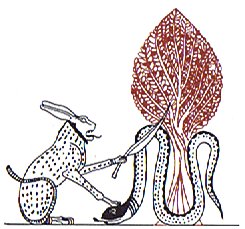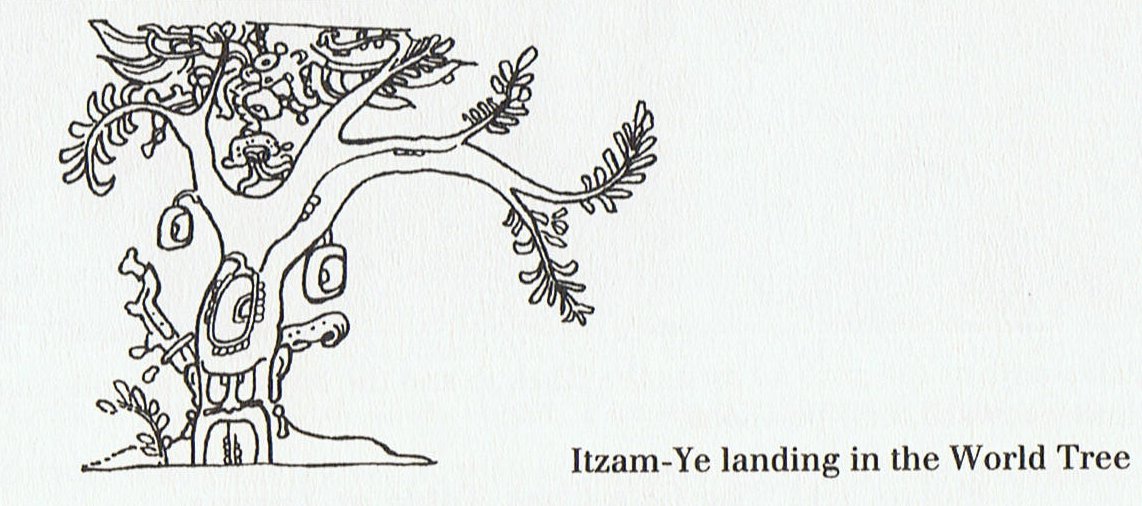|
TRANSLATIONS
In Polynesia insects like flies were important enough to bring on board the ship of Hotu Matua together with other essential plants and animals. ... From a religious point of view, the high regard for flies, whose increase or reduction causes a similar increase or reduction in the size of the human population, is interesting, even more so because swarms of flies are often a real nuisance on Easter Island, something most visitors have commented on in vivid language. The explanation seems to be that there is a parallel relationship between flies and human souls, in this case, the souls of the unborn. There is a widespread belief throughout Polynesia that insects are the embodiment of numinous beings, such as gods or the spirits of the dead, and this concept extends into Southeast Asia, where insects are seen as the embodiment of the soul ... According to the principle of pars pro toto a bee may be used to represent also flies and other insects. Here high up in Sweden the flies and other flying vermin arrive well into summer. In ancient Egypt a wasp was connected with high summer and the 'cat-hare' killing the 'night-snake' presumably was a parallel to the 'monkey' :   ... The 'tree of life' (in the hieroglyphic sign nehet) was (according to Wilkinson) a 'sycomore' or 'mulberry fig tree', but in the two pictures above we instead see isched, probably Mimusops Schimperi. Via Wikipedia we will first take a look at the Ficus Sycomorus:
'... F. sycomorus is in the Near Orient a tree of great importance and very extensive use. It has wide-spreading branches and affords a delightful shade. The ancient Egyptians cultivated this species 'almost exclusively', according to Zohary and Hopf. Remains of F. sycomorus begin to appear in predynastic levels, and in quantity from the start of the third millennium BC. Zohary and Hopf note that 'the fruit and the timber, and sometimes even the twigs, are richly represented in the tombs of Early, Middle and Late Kingdoms. In numerous cases the parched sycons bear characteristic gashing marks indicating that this art, which induces ripening, was practice in Egypt in ancient times.' Although this species of fig requires the presence of the symbiotic wasp Ceratosolen arabicus to reproduce sexually, and this insect is extinct in Egypt, Zohay and Hopf have no doubt that Egypt was 'the principal area of sycamore fig development.' Some of the caskets of mummies in Egypt are made from the wood of this tree.' I notice that a tree can give shadow (a possible meaning of GD28, mauga). I also read that the leaves of this tree are arranged 'spirally around the twig', that the inner bark is yellow, and that some mummy caskets were made from wood of this tree. Furthermore, that the leaves are dark green on one side and 'lighter with prominent yellow veins' on the other side. Wilkinson says that in chapter 109 of the Book of the Dead two 'turquios sycomores' are standing at the eastern gate of the sky, where the sungod Ra enters. The sycomore was a manifestation of the 3 goddesses Nut, Isis, and Hathor, a manifestation by the name 'The Sycomore Lady' ... I guess the 'bee' in the center of the day is the extinct sycamore wasp:
I write 'night-snake' because I am convinced the sun-cat (or -hare) cut the 'snake' of darkness, just as the sungod Marduk cut the night (water) monster (Tiamat) in half. We have seen that in rongorongo the night is divided in half by a variant of henua (the sunlit earth alias the tree of life which the 'monkey' inhabits):
And we should remember the thirsty Raven who blamed the snake and who lied (talked crooked): '... the bird, being sent with a cup for water, loitered at a fig-tree till the fruit became ripe, and then returned to the god with a water-snake in his claws and a lie in his mouth, alleging the snake to have been the cause of the delay. In punishment he was forever fixed in the sky with the Cup and the Snake; and, we may infer, doomed to everlasting thirst by the guardianship of the Hydra over the Cup and its contents. From all this came other poetical names for our Corvus - Avis Ficarius, the Fig Bird; and Emansor, one who stays beyond his time; and a belief, in early folk-lore, that this alone among birds did not carry water to its young ...' South of the equator our winter becomes summer, and Antares must be watched in the morning instead of in the evening or the old month calendar will no longer be useful. Changing the observations 180º around is similar to changing the seasons 180º around. But even if the calendar months now can be kept, with the stars appearing in proper order, it is spring Antares announces, not autumn. Changing the time of the day (e.g. from evening to morning) is connected with changing the time of the year (e.g. from autumn to spring). Moving in space a long way across the equator and down to Easter Island at the southern extremity of the Polynesian triangle demonstrates how time of the day, time of the year and space are related. Cosmos is a time-space structure. On Easter Island Tagaroa no longer is located in the west - Tagaroa Uri, the Great Green Man, stands up at the beginning of the 2nd quarter, and fishing will no longer be taboo. The 2nd quarter lies in the east. When light is absent, it is night, the real life has gone and what remains is only dreaming and waiting. The light of fires live in dry trees. When day comes the manmade fires no longer are needed, the great fire in the sky is more than enough. Logically high up there must be trees too. Day arrives with light not only in the morning but also in spring. The tree of light (life) is the ceiba in America: ... Yucatan crosses today are ... referred to as yax che', 'First (or green) Tree'. Yax che' also happens to be the name of the ceiba tree, and we have naturalistic images from the Classic period of fruit-laden ceibas that represent the World Tree ...
... The form they gave to the Raised-up-Sky and the central axis of the world was that of a great ceiba tree. That tree is still there as the cross and as the tree ...
... As the Milky Way turns from its north-south position as World Tree to its east-west position as the Cosmic Monster, it arches from the southwest to northeast quadrants of the sky. At that time it looks as if the crocodile is riding just above the swollen bulge of its base. This 'crocodile tree' is a very ancient image among the Maya and is featured in Popol Vuh version of Creation. In fact, a monument from the very early ceremonial center of Izapa in Chiapas shows this crocodile tree along with a picture of one of the Hero Twins after his arm has been ripped off in a struggle with Itzam-Yeh, the Classic name for Seven-Macaw. With his good arm he is holding a pole on which a Late Preclassic-period version of Itzam-Yeh perches.
If Itzam-Yeh was symbolized by the Big Dipper in the Classic period, this picture also happens in the sky. When the Wakah-Chan Milky Way moves from its erect north-south position and becomes the Crocodile Tree, the Big Dipper dives downward until it touches the horizon. It disappears as the Crocodile Tree changes into its east-west Cosmic Monster. I believe this movement may correspond to the defeat of Seven-Macaw by the Hero Twins ... And now back to the flowers and the bees (a sexual image): ... Most of the people in our van took advantage of the interlude to shop at the nearby stalls set up by highland Maya who had come down to Tikal to take advantage of the steady supply of tourists. However, one of our group, Harriet Gillett, a retired physician and an inveterate bird-watcher, had other interests. She noticed a nearby tree hevy with white blossoms and surrounded by a raucous sphere of birds and bees. She climbed out of the van with her binoculars around her neck, and walked over to take advantage of the unexpected opportunity the morning had provided. Our local guide, Francisco Florián, who knew the forest and its creatures in an unusually intimate way, joined her, explaining that the birds came to the tree only early in the morning. The sounds and the odd sight finally drew my attention and I too disembarked from the van and edged closer to the buzzing center of the action. I stared at the screaming birds as they fought for positions among the flowers and the hovering drone of thousands of bees. How beautiful, I thought, and then my gaze happened to settle on the trunk of the tree. It had thorns and it bulged just above the ground. It was a young ceiba tree.
I already knew that the ceiba tree was the model for the sacred World Tree of the Maya, but I had never seen one in flower when I knew what I was looking at. I was really excited because normally you can't see the blossoms even if you're there when the tree is in blossom. The fully mature trees are hundreds of feet high. and the blossoms are very small. 'It's a ceiba', I chirped and began looking for a branch low enough to see one of the blossoms up close. Joyce Livingstone, a retired teacher, did the logical thing. She bent over, picked up a fallen branch, and held it out for me to see. I was too excited and full of myself to listen. She tapped my arm more insistently and still I didn't hear her. Finally, in frustration, she grabbed my wrist and raised her voice. 'Will you look at these?' she said, waving the branch, and finally I did. What I saw stunned me, for in her hand lay a perfect replica of the earflares worn by the Classic Maya kings. Suddenly I understood the full symbolism of so many of the things I had been studying for years. The kings dressed themselves as the Wakah-Chan tree, although at the time I didn't know it was also the Milky Way.
The tzuk [partition] head on the trunk of the tree covered their loins.
The branches with their white flowers bent down along their thighs, the double-headed ecliptic snake rested in their arms, and the great bird Itzam-Yeh stood on their head. I already knew as I stood under the young tree in Tikal that the kings were the human embodiment of the ceiba as the central axis of the world. As I stood there gazing at the flowers in Joyce's hand, I also learned that the kings embodied the ceiba at the moment it flowers to yield the sak-nik-nal, the 'white flowers', that are the souls of human beings. As the trees flowers to reproduce itself, so the kings flowered to reproduce the world ...
|







